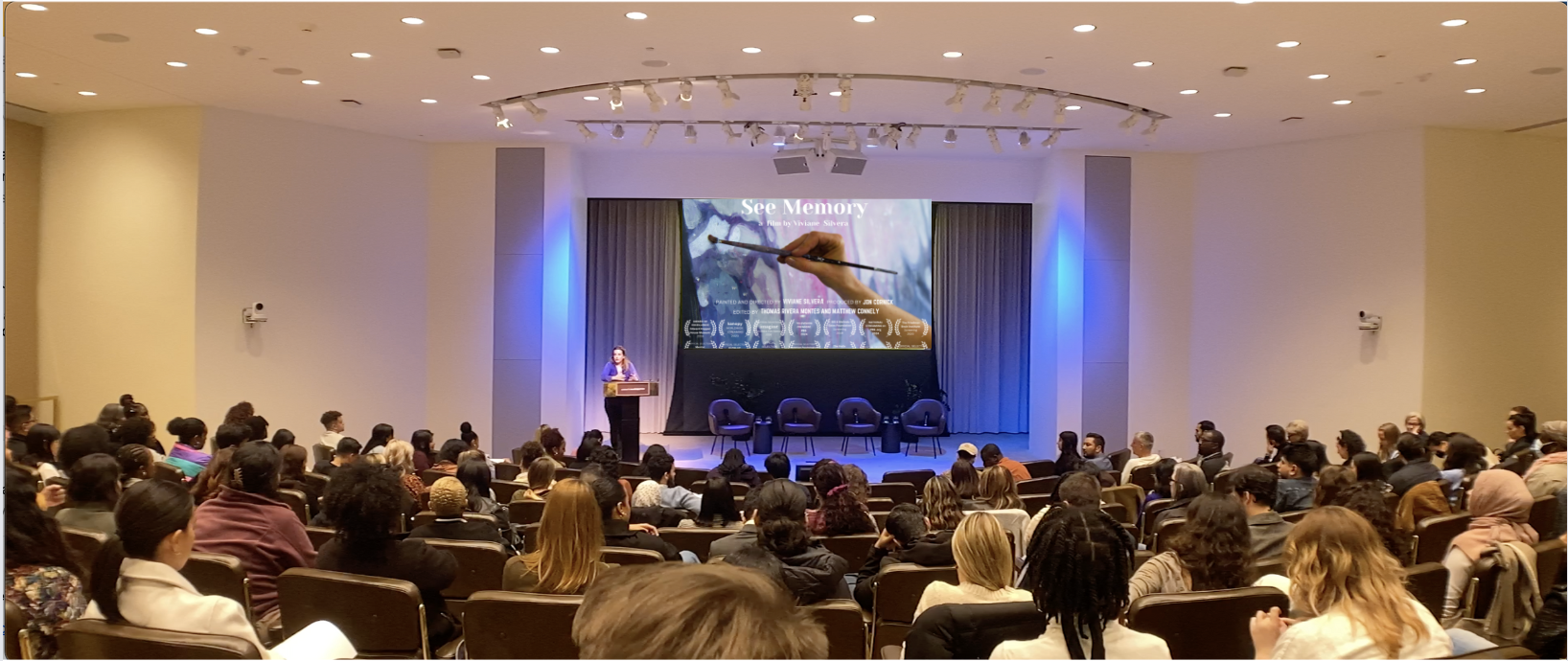
Recent Recognition
🏆 Featured Profile, The Telly Awards (2025)
→ Read the article
🏆 2025 Telly Award
SEE MEMORY was honored with the 2025 Bronze Telly Award in 2D Animation, recognizing excellence in hand-drawn animated storytelling.
Directed, painted, and animated by Viviane Silvera, the film is composed of over 30,000 individually hand-painted frames. It visualizes how memory is formed, fragmented, and reshaped—bridging neuroscience, trauma research, and visual art.
SEE MEMORY has now screened at over 50 institutions worldwide, including Yale, UCLA, Tufts, Vassar, the Friedman Brain Institute, The Edward Hopper House, and the Bill & Melinda Gates Foundation.
🎬 Now booking for 2025–2026:
Bring this award-winning film to your university, museum, or mental health organization—and invite Viviane Silvera to speak about the artistry, science, and healing behind it.
THE STORY OF SEE MEMORY
Once upon a time, memory was believed to be a perfect recording of our past—a fixed and reliable archive of who we are.
People lived their lives shaped by these memories, unaware that what they recalled was not always the full truth, but rather a story their brain constantly rewrote.
One day, scientists discovered that memory is not fixed—it is fluid, shaped by trauma, emotion, and even external forces like stress and environment.
Because of that, people struggling with painful memories began to wonder: if memory is constantly evolving, could they reshape their past—not by erasing it, but by understanding and reframing it?
Because of that, SEE MEMORY was created—a visually stunning film made from over 30,000 hand-painted stills, weaving together cutting-edge neuroscience and deeply personal storytelling to illuminate the way memory works, how trauma reshapes it, and how art can help us heal.
Audiences saw their own pasts with new eyes, realizing that while they cannot change what happened, they can change the way they see it—turning even the darkest memories into something meaningful and full of light.
Explore how SEE MEMORY can spark conversations and healing in your community.
BRIDGING ART AND SCIENCE TO HEAL TRAUMA AND INSPIRE HOPE
“A stunning dramatization of the complexity and emotional power of human memory. An entirely new way of imagining memory, trauma and emotional experience. It’s beauty is matched only by its brilliance.”
- R. John Williams, Professor, Yale University

REACHING NATIONAL AUDIENCES
Filmmaker and painter Viviane Silvera has been recognized for her work in national publications and podcasts.
THE SEE MEMORY PROJECT
"Art captures the personal, emotional experience in a way science cannot."
-Daniela Schiller, PhD. The Schiller Lab, Mount Sinai
Through it’s unique and accessible blend of art and science SEE MEMORY can reach people of ALL AGES, many who cannot otherwise be reached
SEE MEMORY helps parents, children, teachers, and therapists build trust and understanding through shared conversations about memory.
SEE MEMORY can be used as a therapeutic tool
“I began to use excerpts as an augmentation tool to psychotherapy with patients who have been victims of trauma. The response has been outstanding.”
-Dr. Silvana Riggio, Icahn School of Medicine at Mount Sinai

SEE MEMORY IMPACT
Our memories don’t have to define us. We can reimagine them and, in turn, create new possibilities for our future.
SEE MEMORY at the Bill and Melinda Gates Foundation Headquarters in Seattle
“Art tells you how to listen to yourself. It teaches you to live dynamically with your memories.”
Daniela Schiller PhD. Director of the Schiller Lab, Icahn School of Medicine at Mount Sinai in THE SCIENCE BEHIND SEE MEMORY
“A mesmerizing film that will enchant and enlighten anyone interested in the mystery of memory and its relationship to trauma. SEE MEMORY illuminates pathways to hope."
Dale Kushner, Psychology Today
OUR SCREENING PARTNERS
SEE MEMORY and The See Memory Project are made possible by generous partners who recognize the need for the use of art to express science, spread understanding and a compassionate approach to mental illness. We extend our deepest graditute to:

“A beautiful thing, a film that stimulates both the heart and the mind”
- Kent Hill, Film Threat
“Bridges art and science to communicate profound insights about memory."
- Camilla Dangot, Brown University Art Paper
“Opens the door to understanding the science of memory. The response has been outstanding.”
Dr. Silvana Riggio, Professor of Neurology & Psychiatry, Icahn School of Medicine at Mount Sinai
“Blends art, therapy and science seamlessly.”
Paul Browde, M.D, Narrative Medicine, Columbia University
“I was thoroughly impressed by the film's insights about the dynamics and subtleties of memories.”
Daniela Schiller, Ph.D. Director of the Schiller Lab, Icahn School of Medicine at Mount Sinai
“The best part of our event was See Memory and the Q & A with Viviane. ”
Michele H. Jacob, PhD, Neuroscientist, Tufts University
“Offers beautiful, reframing language that can support those with an often overlooked diagnosis.”
Gina Smith, International Rescue Committee
“Illuminates pathways to hope.”
Dale M. Kushner, author of The Conditions of Love and M, columnist for Psychology Today.
“An amazing introduction to how traumatic memories form an impediment to living one's life to its fullest and a tool to combat stigma around mental health."
Ramina Bebezova, Tufts University, Coordinator of Student-led Mental Health Organization












